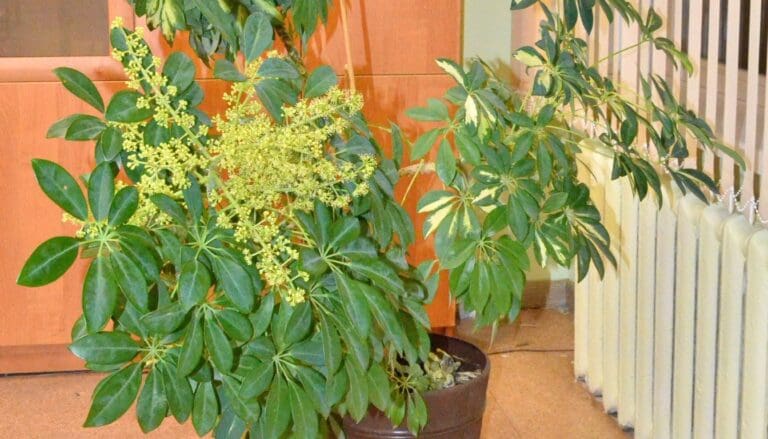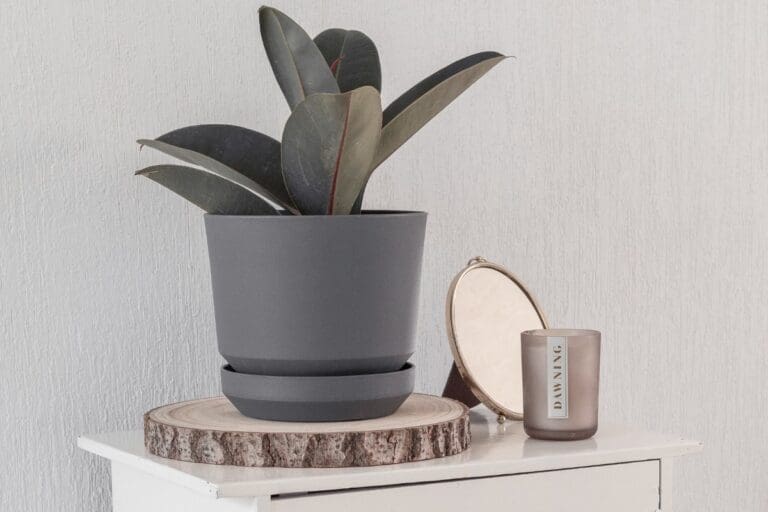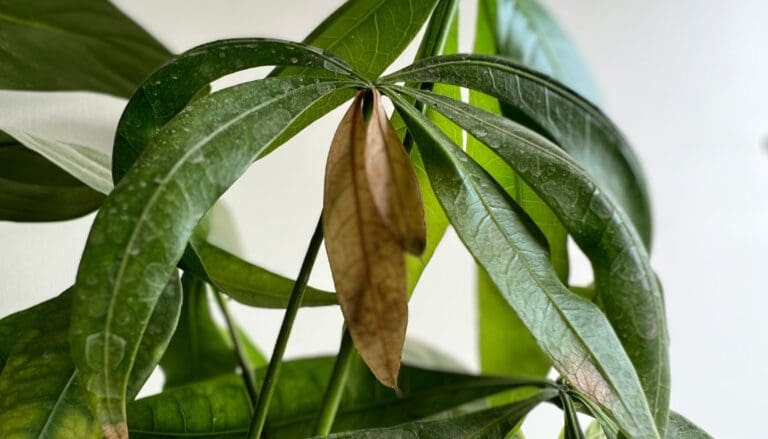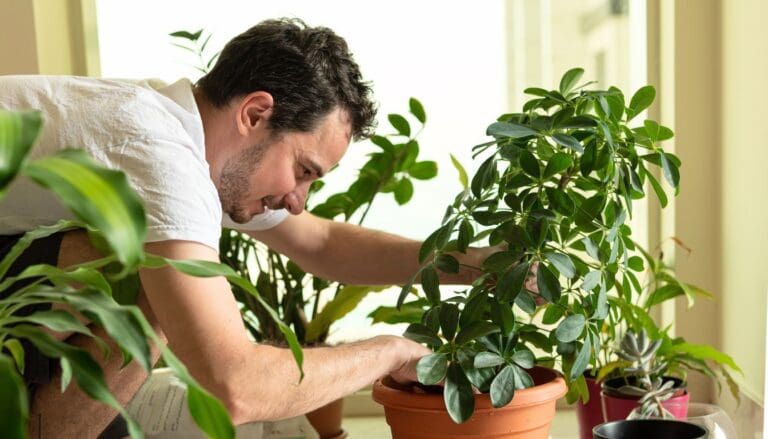How Often To Water Croton Plant? (Watering Schedule+Watering Problems)
Crotons are native to the western islands of the Pacific Ocean, Malaysia, Australia, and Indonesia. They are famous for both outdoor plants and houseplants. Watering a Croton correctly is quite tricky, especially if you are a beginner at it.
So, in this article, we shall learn all about watering croton plants.
As a general rule, you must water your croton 1-3 times a week, depending on how quickly the soil dries out. Before watering, always check the soil’s moisture by touching the soil or using a moisture meter and water only when the top ½ inch of the soil is dry.
Crotons are tropical plants that will need lots of water. If you are a newbie at growing a Croton, this guide has everything you need to know about watering them. Alongside, we will also cover information about underwatering and overwatering.

Please note: Simplify Plants is reader-supported. Some links in the post are affiliate links and I get a commission from purchases made through links in the post.
Why scheduled watering fails for Crotons?
A fixed schedule to water Crotons is never successful, especially for Crotons. Let me explain. You make a routine of watering the Crotons only 1-2 times a week, no matter what.
If you continue watering them once or twice a week, the plant will face difficulties in winter. Crotons slow down their growth in winter and thus don’t absorb much water. As a result, they undergo overwatering problems.
If you continue watering once a week, the bigger plants will have issues in the summer. Due to hot and dry weather, the plant will consume more water to stay hydrated. Besides, the bigger the plant, the more water they need.
Watering once a week will not be enough. As a result, the Crotons will have underwatering.
Providing the plants with the same quantity of water at the same frequency will lead them either to overwatering or underwatering.
The plants will have droopy leaves, wilted leaves, falling leaves, root rot, and many other issues. That is why a scheduled watering doesn’t work.
Which factors affect the watering frequency of Crotons?
Understanding the right amount of water is easy. But understanding the right frequency depends on many aspects.
Watering according to those aspects will save your plant from many issues and help your Crotons survive in the long term.
Watering depends on the size of your Croton plant.
Crotons will grow up to 3 feet in height, and their lovely multi-colored leaves will spread about 2 feet wider as a houseplant. Your plant will be more or less within this size. The larger the plant, the more water it will absorb.
The bigger plants lose moisture faster because they absorb water more. The large plants also use cell water more by respiration. Thus, they will require water frequently.
However, it doesn’t mean that the smaller ones will need less water. The younger plants will also need water more often because they grow energetically.
While the large plants need significantly less water when they are not growing actively, the smaller plants will still require frequent watering because of their continuous growth until they reach their potential.
Also read: How Fast Do Crotons Grow? (Croton Growth Rate)
Watering depends on the temperature around the Crotons.

Crotons require a temperature of about 60-85°F around them. With higher temperatures, the respiration rate increases. It will no doubt increase Croton’s water requirement more often.
When the winter arrives, the temperature will drop. In such climates, the Crotons slow down their growth. You need to reduce the watering frequency in such low temperatures.
Croton watering and humidity
Crotons are native to the tropical forests of Southeast Asia and Australia. It is a hint that Crotons will love lots of high humidity.
Crotons will have faster transpiration and need watering more often if the humidity level is low around them. It is more applicable during dry summers. Repeated misting will help to keep them moist.
Also read: Do Crotons Need Misting? (+Maintaining Ideal Humidity)
The size and type of container can affect watering.
If you practice gardening, you must have known by now that clay or terracotta pots are porous materials that wick away moisture quickly. On the other hand, plastic pots hold moisture for a long time.
So, if your Crotons are standing on a terracotta pot, you have to water the plant more often than the one standing in a plastic container.
The size of the container should always rely on the size of the plant. If the container is too big, it will need more soil and water, which will take forever to dry.
If you have placed your Crotons in a big pot, you have to be easy on watering to prevent overwatering. Water when the top half-inch of soil dries.
Always grab a container possessing enough drainage holes to drain out excess water.
Also read: What Kind Of Pot For Croton? (Pot Size, Material & More)
The type of potting mix can guide you with how often to water Crotons.

The best soil for Crotons is well-drained, fertile soil that will drain excess water and retain moisture. In such potting soil, you can maintain regular watering.
But if the soil is terrible in drainage, compact and heavyweight with lots of organic ingredients, it will hold moisture in the long term. In such conditions, you have to reduce the watering frequency for Crotons.
You can improve the soil’s drainage by adding porous ingredients like perlite, vermiculite, or sand. These ingredients will help the soil dry faster to do regular watering.
Also read: What Kind Of Soil Does A Croton Need? (+Ideal Soil Mix & Requirements)
Time of the year is important.
The season also affects the watering frequency of Crotons. From the early spring till the first half of fall, the Crotons will need water frequently. Their active growth will make them consume more water at this time.
From the second half of the fall, Crotons will gradually decrease their growth. Once the temperature begins dropping, the plant will reduce its consumption speed.
As a result, they will absorb water very slowly. So, you can cut back the watering frequency in winter.
Watering and Ventilation
Good air circulation is essential. It reduces the risk of pests and fungus diseases. It helps dry out the damp soil and the leaves so that the plant doesn’t suffer from any stress. There will be no arrival of pests or fungus
in a healthy plant.
But the plant will need water more often. Because of good ventilation, the plant will dry out quickly. It speeds up the evaporation rate, thus increasing the demand for watering.
Exposure to sunlight
Crotons need full or partial sun for growth, depending on the variety. Especially the variegated varieties need full sun for 6-8 hours.
When exposed to direct sunlight, they lose moisture faster. The more exposed Crotons are to the full sun, the more often they need watering.
The varieties receiving indirect sunlight will consume water at a slow pace. Thus, they need water less often.
Also read: What Kind Of Light Does A Croton Need? (Croton Light Requirements )
How often should I water the Crotons after repotting?

Though Crotons reach up to 3 feet in height, they are considered slow to moderate growers that need re-potting every 2-3 years.
Repotting with new soil in a new pot boosts their growth with fresh nutrients and gives them space to grow and spread comfortably.
After you repot your Croton:
- Water them deeply until excess water drains out of the drainage holes.
- Ensure that the water reaches the plant’s root system.
- Use a container having drainage holes to avoid overwatering and root rot.
- Water the plant from the above. After that, you can water from below.
How do I know when my Crotons are thirsty?
For a beginner, it is not easy to understand Croton’s watering needs. It requires years of practice to know the specific symptoms. Along with plant inspection, run some soil moisture tests to confirm when they need water.
Read the following points to understand when the plant is thirsty:
Check the moisture level by finger.
Poke your finger into the soil and try to find out if the top ½ inch feels dry. Water the plant very well. If the soil is still moist, you have to wait for some days to water them again.
Check the color of the potting soil.

When the growing medium is too dry, its color appears lighter than its original color with some greyness. When the soil turns light and grey, that means the plants are thirsty.
Check the moisture level once to confirm your guessing. If the color of the soil is original or darker, they probably don’t need water.
Lift the pot to weigh it.
When you are done with the above, to confirm more, lift the planter. If the plant needs water, the container will feel light on weighing. But if it is heavy, then it doesn’t need water.
Use a moisture meter.
If you want more confirmation or direct confirmation, use a moisture meter. It saves your time from the above-repeated checking and guessing.
The measurement in the kit will give you the exact results whether the plant presently needs water or not.
Insert the moisture meter ½ inch downwards in the potting soil. You can also push it 2 to 3 inches deeper. If the result is between 1 and 3, the plant needs water.
There are also moisture meters available in the market that show the soil’s pH and temperature.
Are my Crotons overwatered or underwatered?
Crotons like to be consistently moist. Prolonged drought or dampness makes the plant dehydrated and vulnerable to infestation.
However, you can save your plant if you take action immediately after noticing the signs of overwatering or underwatering. Taking steps earlier will improve the plant’s health and encourage fast recovery.
Underwatered Croton
More or less, all the houseplants suffer overwatering and underwatering at some point. Even experts commit mistakes. However, you can fix underwatering without letting the plant die.
When you underwater the plant, it will display some symptoms, trying to tell you that they are thirsty. But, continuously neglecting the signs will kill your plant one day for sure.
The signs of an underwatered Croton are:
Limping and drooping leaves
I explained earlier how humidity and watering are linked. The lower the humidity, the more water Crotons need. The plant’s leaves will be limp and drooping when they run out of water.
While checking the soil moisture, you will find that 2-3 inches of the topsoil are bone-dry. You can fix it by watering them immediately. Water thoroughly until excess water drains out of the holes.
If the soil feels a bit hard, you can water them with little lukewarm water. It will ease up the soil compactness faster.
Also read: Why Are My Croton Leaves Drying? (Possible Problems+Solution)
Shriveling leaves
When you don’t water the plant properly for a long time, it will suddenly start to shrivel or wrinkle.
It can also happen due to pest infestation, root rot, and heating the roots. Check for pests and root rot before watering. Or else, instead of saving the plant, you will be risking the plant’s life more.
Watering less will make the roots overheated, due to which the leaves will start shriveling. Thoroughly watering the plant will hydrate it and cool down the heated roots.
Dried and fallen leaves
Crotons are all about their striking leaves. You will not enjoy the scene when their leaves become dry, crispy, and start falling off. It happens when the plant is underwatered.
First, the bottom leaves will begin to dry and fall off. Water the plant thoroughly when you see such symptoms.
Also read: Why Is My Croton Dropping Leaves? (Causes+How To Fix)
Browning at the tips and edges of leaves
Loss of moisture will always lead to browning of the leaves at their tips and edges. It can be either due to low humidity or underwatering or both together.
Even if the plant is getting low humidity, watering it more often can solve the problem of low humidity. Ensure suitable moistness in the plant’s soil.
Also read: Why Are My Croton Leaves Turning Brown? (Causes+How To Fix)
Brown or yellow leaves

When Crotons suffer underwatering, their leaves will turn dry and crispy, yellow and brown. Notably, the signs will begin emerging from the outer margins.
But, if you find brown dots with yellow halos, that is not an underwatering symptom. It’s a disease.
Overwatered Croton
Underwatering is easy to fix. But overwatering is risky and life-threatening. Prolonged overwatering will cause root rot. In such conditions, it becomes challenging to revive the plant back.
Also read: How To Save Overwatered Croton Plant? (Signs, Problems & Solution)
Some signs of overwatering are:
Wilted or yellow leaves
In most houseplants, wilted leaves are signs of underwatering. But in Crotons, the plant wilts because of overwatering.
For underwatering, check for signs of falling leaves. When overwatered, they will wilt and turn yellow. When this happens, stop watering. Let the soil dry before the next watering.
Leaf dropping
In underwatering, only the bottom leaves fall off the plant. But if it is overwatering, all old and new leaves will drop off. When you see leaves falling from the plant, check the moisture level.
It will not only feel moist deep down, but some wet soil will even stick your fingers.
Brown spots
When your Croton is overwatered, you will see soft, water-soaked brown dots on the surface.
In severe cases, it will increase the risk of fungus diseases. At that time, these brown spots will be encircled by yellow halos.
Waterlogged and moldy soil

When touched, the soil will feel wet. You will see white mildews, molds, and various fungal developments in the soil due to soggy soil.
Root rot
At last, your Crotons will be fighting nature’s nightmare. When root rot occurs, it becomes troublesome to save and revive the plant in some cases.
Maximum roots become dark brown, black, or mushy. The soil will also release a foul smell. You have to remove these damaged roots and re-pot them in new soil to fix this issue.
If you want to save your plant from such conditions, take steps when you find the initial signs of overwatering, like wilted or yellow leaves.
Some tips about watering Crotons
Maintain moist soil for the Crotons. It may be confusing initially, but you can master it with daily practice.
To keep the Crotons from overwatering, allow the top ½ inch of the soil to dry out before the next watering.
Water the Crotons when the top 3-inch soil is dry in the winters. It will also keep your Crotons from underwatering.
If you have kept any saucer beneath the pot, throw the water away from it after some minutes. It prevents both overwatering, root rot, and infestation.
To ensure that water reaches the roots, water thoroughly until the water drains out from the pot. Use appropriate soil mixes with proper drainage. Add sand, perlite, or wood chunks to improve drainage.
Crotons may either need daily watering or once a week. Instead of waiting for days, check the moisture daily and water the plant.
Don’t use tap water. Use distilled water or pure rainwater to water the Crotons. Tap water contains hard minerals which can damage the roots and deteriorate the plant’s health.
How to water the Crotons?

There are two ways to water houseplants. Most houseplants prefer watering from below. It ensures that the water reaches the roots.
Top watering is avoided because damp leaves can invite pests and fungal diseases. For Crotons, the situation is different.
Watering a Croton from the top
A Croton is excellent if watered from above and water got splashed on the leaves. Water splashing in their leaves helps increase the humidity.
Just make sure that water reaches the bottom and soaks the soil. Water must drain out of the drainage hole. Only then, top watering will be successful.
Tilt the container to pour out the excess water after 10 minutes of watering if you find Crotons are standing over stagnant water. Again water when ½ inch of topsoil dries. In winter, it should be 2-3 inches.
Watering a Croton from below
This is common for most houseplants. It ensures the water reaches the roots. But be careful about not overwatering them.
When the soil feels dry, place it over a saucer and water thoroughly until water drains out.
Let the pot sit over the saucer for 10-20 minutes. It will make sure the soil is moist enough. Then remove the saucer and let the pot drain water if still left to drain.
Final thoughts
Crotons will be growing great as an indoor plant. They will make your interior impressive because of their colorful leaves. Some say that they require very much attention, but that is not the case.
Usually, they require full or partial sun, regular watering, warm temperatures, and high humidity to thrive. These requirements are the same for all tropical plants.
If you already have a lot of tropical plants, then adding Croton to the list will not bother you much.
Reference: Sciencedirect, Wikipedia, Wikipedia, Britannica, CABI, Academia, University of South Florida, The University of Georgia.
Recommended Garden Supplies
| Product Image | Our Recommended Gardening Supplies | Check Offers! |
|---|---|---|
Top Top
Top
Top
Top
Top
Top
Top
Top | rePotme Houseplant and Tropical Classic Potting Soil Mix | Check Offer On Amazon |
 Top
Top
Top
Top
Top
Top
Top
Top | Espoma Organic Indoor Plant Food | Check Offer On Amazon |
 Top
Top
Top
Top
Top
Top
Top
Top | GooingTop LED Grow Light 6000K Full Spectrum Clip Plant Growing Lamp | Check Offer On Amazon |
 Top
Top
Top
Top
Top
Top
Top
Top | Soil Moisture Meter | Check Offer On Amazon |
 Top
Top
Top
Top
Top
Top
Top
Top | Govee Hygrometer Thermometer, Bluetooth Enabled! | Check Offer On Amazon |
 Top
Top | LEVOIT Humidifiers for Large Room(Best For Plants) | Check Offer On Amazon |
 Top
Top
Top
Top
Top
Top
Top
Top | Upgraded DIY Automatic Drip Irrigation Kit, 15 Potted Houseplants Support | Check Offer On Amazon |
 Top
Top
Top
Top
Top
Top
Top
Top | Stainless Steel Heavy Duty Gardening Tool Set | Check Offer On Amazon |
 Top
Top
Top
Top
Top
Top
Top
Top | Bonide Insecticidal Soap | Check Offer On Amazon |
 Top
Top
Top
Top
Top
Top
Top
Top | Bonide 32 oz Spray Neem Oil for Organic Gardening | Check Offer On Amazon |
 Top
Top
Top
Top
Top
Top
Top
Top | Garden Safe Fungicide | Check Offer On Amazon |






